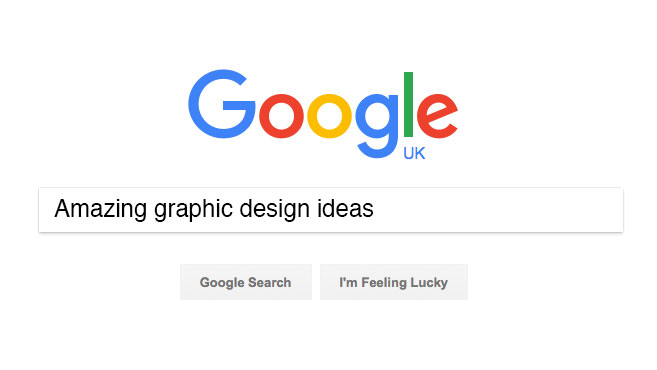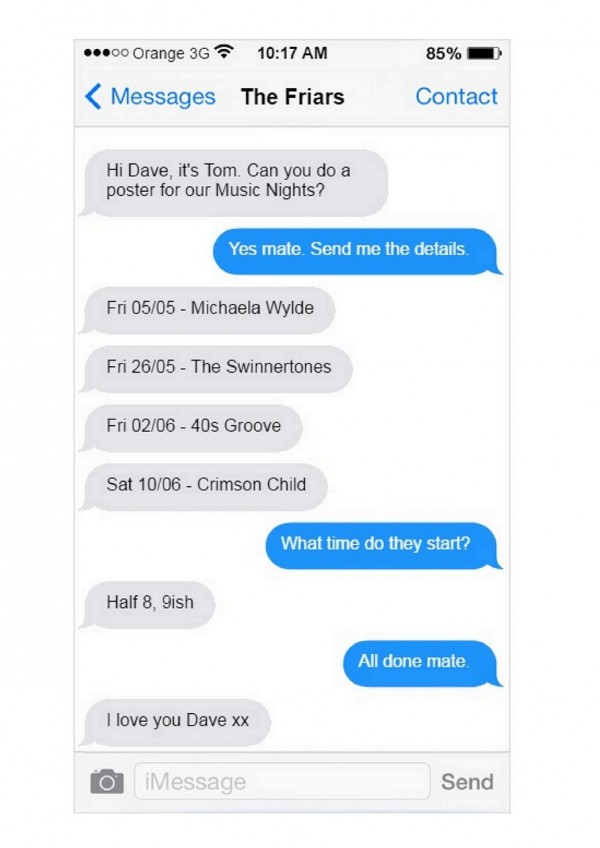Have designers become lazy?
With new tech providing ever more shortcuts into design, have we stopped making an effort?

Jonathan Ford, the founding creative partner and CEO of brand design agency Pearlfisher, recently claimed that “designers have become lazy” (watch the talk here). It might sound shocking, but with the huge influence of technology, social media and viral trends on designers today, does he have a point?
Earlier this year, a bar in Bridgnorth, England, caught the internet’s attention thanks to an 'efficiently designed' poster for its music nights. Looking for all the world like a text exchange between a client and a designer, it went viral as it left viewers wondering if the designer really did simply take a screenshot of his smartphone, send it to the printers and call it a day.

It’s a piece of design so simple and effective that some designers might be left kicking themselves. It didn't showcase stunning photography or deft illustration; rather, on the surface it appears to be laughably, arrogantly lazy. The beauty of the poster is that there’s more to it than meets the eye.
Clever design disguised as lazy design?
On closer inspection you can tease out where Dave Blackhurst, the man behind the poster, has played the realism card perfectly. There’s the 85 per cent battery life, the page indicator and the time of day that isn’t rounded to the nearest five minutes, let alone the hour. Everything about it is so deliberately imperfect, it’s no wonder so many people were temporarily fooled.
Creating a viral poster that makes headlines for a day is the dream of plenty of graphic designers, so it’s comes as a shock that Blackhurst is actually a copywriter. In fact, the inspiration behind the poster came from humorous internet memes, a notoriously crude area of design that has already been accused of heralding the era of bad graphic design.
All of this could be enough to leave graphic designers bereft. Did we waste our time studying? Is it time to throw away our Moleskines and retrain as a plumber? Of course not. However, pieces of meme-influenced anti-design like Blackhurst’s poster do tie into Ford’s accusation that “designers have become lazy".
Predictable thinking

Speaking at TYPO Berlin 2017, Ford made the bold statement as part of his talk on how a high-tech/low-tech fusion leads to creative thinking that can transform lives. In particular, Ford took issue with how powerful tools such as your everyday Google search and Pinterest board have led to a predictable style of creative thinking that leads to unchallenging design work.
Daily design news, reviews, how-tos and more, as picked by the editors.
Unsurprisingly, Ford’s opinion struck a chord with an audience of aspiring designers and seasoned professionals. Johnson Banks' Michael Johnson says that when it comes to the beginning of a design project, there is a tendency among junior designers to be over-reliant on Google images and endless Pinterest boards.

“We’re always at pains to NOT design by mood board, or by what’s gone before and to genuinely search for something new – however hard that might be,” Johnson reveals. “Conversely, senior designers – and yes, creative directors – can sometimes need a gentle kick up the bum because they’re coasting or only doing ‘just enough’."
New technology designed to automate things we once did manually is also a factor. "If we interpret ‘laziness’ in terms of technology, yes, the machinery and some programs do take a lot of the grind out of projects. And, yes, sometimes what the computer can do makes you think in a way that you didn’t before," he continues. "But – the machines never have an idea, and they definitely can’t hold a pencil.”
Making an effort
As we’ve seen from Blackhurst’s poster, which was created using a basic online text message generator, sophisticated tools have levelled the industry playing field, and opened it up to many who simply wouldn’t have had the chance to get involved before. It’s up to you whether or not this is a good or bad thing, but as far as high-end signmaker Luke Stockdale is concerned, the best designers still need to know their craft to succeed.
The owner and creative director of Sideshow Sign co argues that while his area of the design industry has become lazy, sign fabricators still need to understand the essentials of construction and the materials involved.

“When any new technology comes in, it has made someone’s life a lot easier and they’ve become lazy. But there are always those people who use it properly, and also make sure they’re learning the fundamentals and respecting it for what it is,” Stockdale explains.
“You take photography, for example. You can go and buy a really nice camera and take a beautiful photo, just point and shoot, which you could never have dreamed of doing 30 years ago. But there’s still the cream of the crop who are pushing it, and are still taking better photos than anyone else, and they still could take those photos with a film camera. Technology makes people lazy. Isn’t that the point? So you don’t have to do anything; so you don’t have to do the work.”
An honest representation
Freeing up creatives from the more tedious aspects of design puts more of an emphasis on perspective, according to Rough Trade magazine’s print designer Bruce Usher. Taking Ford’s comment that designers have become lazy at face value, Usher dismisses the claim for being as lazy as the designers he’s putting down.
“If technology makes it easier for anyone to communicate through design, then surely what we encounter day-to-day can only become more of an honest and exciting representation of what it is to be alive today? That's far more important to me than designers having to work hard to find the right font,” Usher reasons.
“To really have an impact on the visual culture around us now, and be heard, I'd argue that we can afford to be less lazy than ever before – technology provides a platform for us to encounter so many different, incredible voices every day. Thankfully, it's now not enough to simply own the tools of production to have a monopoly on communication – and I find this a far more inspiring culture to be a part of.”

Blackurst’s text conversation poster – shared via Imgur – is definitely a new voice that would never have reached a global audience if it wasn’t for new technologies. Yet the design is also a great example of Michael Johnson’s view that designers should be endlessly searching for verbal and visual solutions that push at the outer edges.
“There are some companies who don’t do this,” Johnson explains. “In fact, there are quite a lot, because ‘pushing at the edge’ takes balls and tenacity and often involves debating ideas that don’t fit neatly into any mould or pre-ordained category. Our ‘Dear World… Yours Cambridge’ idea breaks all the conventions of the education sector, and yes it took some careful explaining to get it through. But it was worth it, both creatively for us, and financially, for them.”
Pushing at the edge takes balls and tenacity, and often involves debating ideas that don’t fit neatly into any mould
Michael Johnson
This throws a spanner in the works, if we're using Blackhurst’s viral poster as an example of lazy design. He might have used tools that make the whole design process much easier, but his work found a unique way to get its message across – one that fooled and impressed hundreds of thousands of people around the world. In fact, given that the poster wasn’t a straightforward screenshot that trades purely off its laziness, you could argue that it’s a perfect example of sophisticated design created by an amateur who made clever use of the tools at their disposal. Not so lazy after all.
A trade-off
So where does this leave us when it comes to judging whether designers have become lazy? Just like television and publishing in the wake of the internet, it seems that the barriers surrounding design have been drastically lowered thanks to powerful tools, not in spite of them.
You’re always going to have people that take shortcuts or produce work that doesn’t follow design fundamentals, but the trade-off is that you see plenty more work from people who previously wouldn't have had a chance of being found.
As for the idea that professionals are resting on their laurels, we’ll leave you with Michael Johnson’s summary of his past year: “I’ve written and published a book, reconfigured our website, pushed through dozens of big global branding projects, written 60 speeches for the University of Cambridge, rebranded Mozilla entirely in the open, and am in the midst of countless speeches and conferences off the back of all this. Generally speaking I take Saturday morning off, if I can, then my week starts on Saturday afternoon and then doesn’t stop. So, not sure if that counts as laziness or not.”

Dom Carter is a freelance writer who specialises in art and design. Formerly a staff writer for Creative Bloq, his work has also appeared on Creative Boom and in the pages of ImagineFX, Computer Arts, 3D World, and .net. He has been a D&AD New Blood judge, and has a particular interest in picture books.
